The ChariTree Foundation is calling on leaders to take urgent, courageous and significant nature-based steps to halt and reverse biodiversity loss.
Montreal, Canada – Global biodiversity is now declining faster than at any time in human history. We are running out of time to take action to stop the accelerating destruction of nature and avoid the extinction of a million species. In this final week of COP15, we must consider children and youth and deliver an ambitious, transformative and measurable Global Biodiversity Framework, or GBF. This includes protecting 30 per cent of the planet by 2030.
“Children love animals and nature and they should be at the heart of all biodiversity decisions. Just as we can’t negotiate with nature, we can’t negotiate with our children’s future,” said Andrea Koehle Jones, The ChariTree Foundation’s lead Children’s Biodiversity and Climate Education Advocate.
More than 17,000 delegates from 200 countries, including NGOs like The ChariTree Foundation (Canada’s national climate education + United Nations Climate Observer organization for children and youth) are in Montreal for the UN Biodiversity Conference also called NatureCOP.
Youth delegates travelled from all over the world to help be a part of the solution:
“Kids are really connected to nature. We are also part of the hope to solve the biodiversity crisis. We really want to be involved.” — Aurora Gomez Espinoza, Global Youth Biodiversity Network, Mexico
“Without human rights there will be no protection of biodiversity and vice versa.” — Esmeralda Wirtz, Global Youth Biodiversity Network, Belgium

The ChariTree Foundation is encouraged by Canada’s Commitment to Indigenous-Led Conservation in the Great Bear Sea and across Canada
One promising sign at COP15 is an increased commitment to Indigenous-Led knowledge and conservation. Canadian Prime Minister Justin Trudeau announced an $800-million investment in Indigenous-led conservation through a finance model first used in the Great Bear Rainforest.
“Indigenous communities leading on this is a really good thing. What we’re able to do here is not just show a story of conservation, but a story of reconciliation, about recognising that it’s these partnerships that are going to be essential going forward,” said Trudeau.
Fifteen years ago, in the Great Bear Rainforest, 27 First Nations partnered with governments, environmental groups, funders and the forestry sector to protect 6.4 million hectares of coastal temperate rainforest. Together, they developed a plan to support stewardship in this region and created the world’s first world’s first Indigenous-led financing organization to manage the protected forests.
Trudeau’s COP15 announcement builds on this and features four large-scale Indigenous-led conservation initiatives that encompass close to one million square kilometres including The Great Bear Sea.
Canada announces Indigenous guardians network to fight climate change
In another positive COP15 development, Steven Guilbeault, Minister of Environment and Climate Change, announced the creation of a new network to help support Indigenous-led environmental initiatives. He said the First Nations National Guardians Network will build on the Indigenous guardians program, which has funded some 170 individual Indigenous-led projects since 2018.

“Outstanding First Nations-led efforts to protect the Great Bear Rainforest Agreement resulted in the historic protection of six million hectares of the ancient temperate rainforest, so Indigenous-Led Conservation is critical to biodiversity protection in Canada and around the world,” said Koehle Jones. “The ChariTree Foundation applauds the creation of the First Nations National Guardians Network.”
In a 2018 expedition to the Great Bear Rainforest we learned first-hand from Coastal Guardian Watchmen. On the shores of the Mussel River deep in the Fiordland Conservancy they taught us about protecting grizzly bear habitat. The expedition was part of The ChariTree Foundation’s LOVE TREES & LOVE SEAS campaign to raise awareness about protecting Canada’s Rainforest Coast.
This protected area of glacially gouged fiords in The Great Bear Rainforest is located in the territory of the Kitasoo/Xai’xais and is collaboratively managed under an agreement between the Kitasoo/Xai’xais and the Province of BC.
Canada also announced a critical $350 million to support biodiversity efforts in developing countries. There’s still lots more to be done to guarantee a historic agreement to stand-up for nature like never before. Parents and kids across Canada and around the world will be watching the final days of COP15 to make sure animals and nature are protected.



